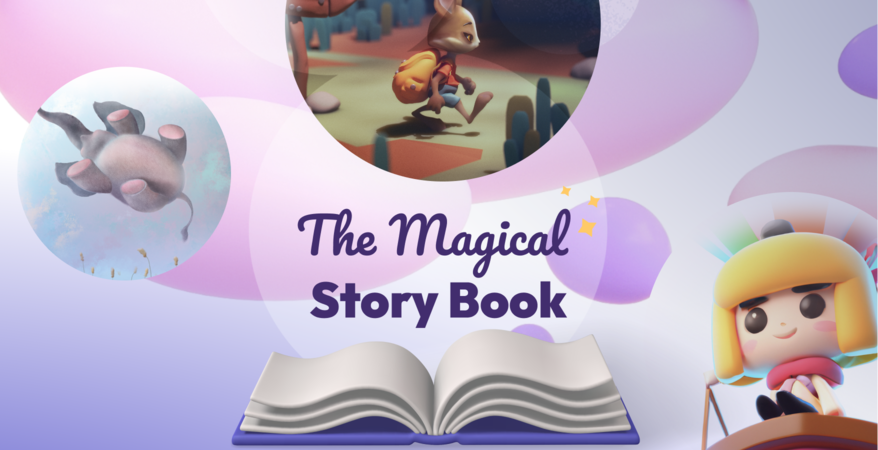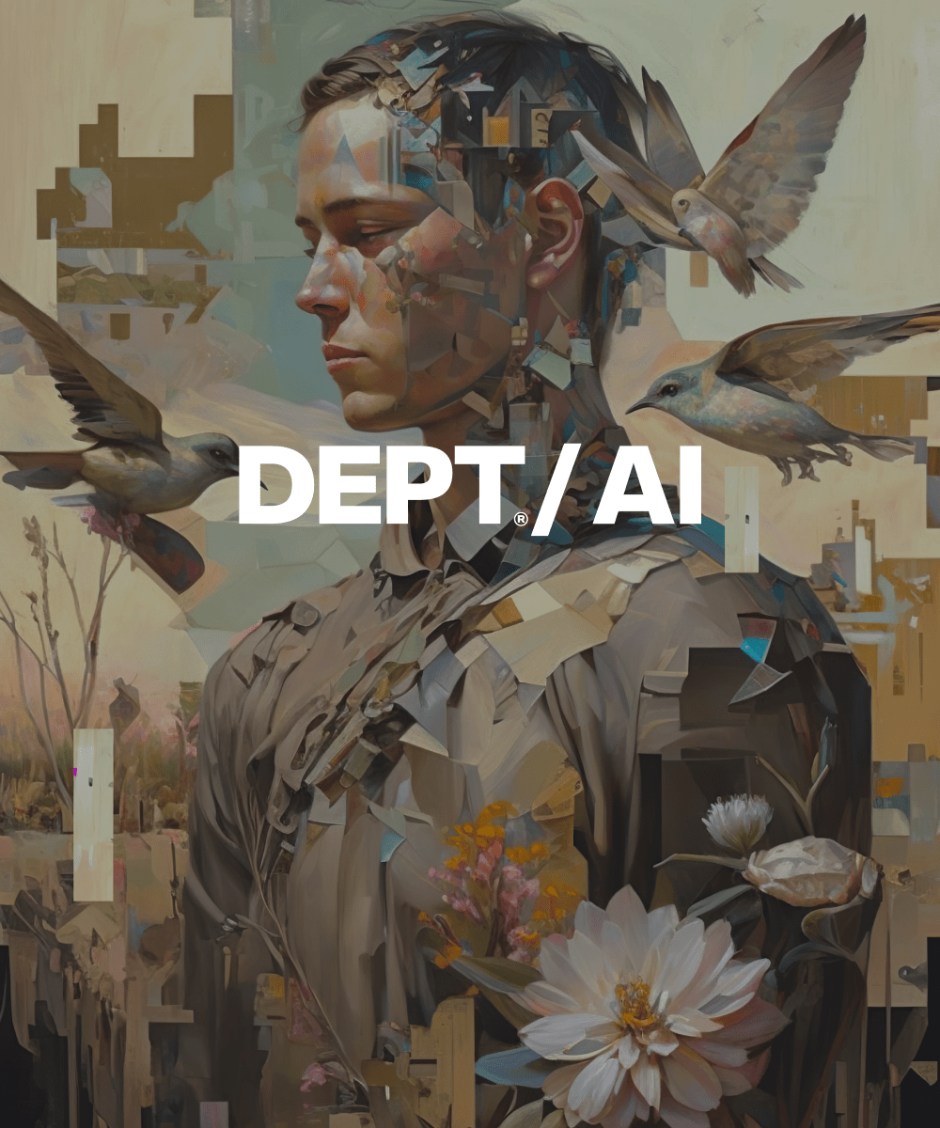AI’s impact across creative, growth, & engineering
2023 is shaping up to be a transformative year for artificial intelligence. AI tools are on track to accelerate and uncover untapped possibilities in tech, marketing, and the creative industries altogether.
The next few years will be critical in defining the future of our industry and how we work together. To stay ahead, we’re taking a deep dive into AI’s most transformative impact across the creative, growth, and engineering sectors.
Impact 01
AI will meet the creative industry’s need for accelerated imagination

“Right now, creative AI is impressive. But it’s only as good as the real-life creative using it.”
Steven Denekas, VP of creative
Here’s how you can leverage creative AI today, courtesy of some of the best minds in AI + creative technology.
Open up exciting new formats for storytelling & embodied experiences
From Nadia Piet, Head of Creative Tech
- AI can help create and amplify experiences by making them interactive and tailored to each user.
- AI creates new opportunities for storytelling through generative podcasts and non-linear films. Can you re-imagine your communication from a broadcast to a conversation?
- AI enables embodied ways of interacting with machines through gesture and voice to really drive your campaign message home. How might you bring your brand to life beyond static content?
Embrace these tools to increase efficiency and improve output
Lauren Chester, Director of tech projects @ DEPT®
- Use Dall-E and mid-journey (and many others) to accentuate your work. But use it with an open mind.
- Write with intent to get the most out of your prompts. Be prescriptive (e.g., say orange not bright). Ensure the structure and content of your sentence gives the context you need.
- Think about the parts of the process that can create efficiencies. From assets to creation, especially when we need lots of variety or a fast turnaround, to make the output more dynamic/interactive.
- Use them to help you make your point. Inspiration for a creative brief, references for a pitch. Rather than searching online, create what you need in minutes.
Improve creativity and create elements or storyboards faster
Jiri Dudek, Lead Motion @ DEPT®
- Experiment with combining different AIs and harness the power of ChatGPT to create bulletproof prompts for Midjourney. Use the creative power of these tools for delivering engaging storyboards or pitches.
- Learn to incorporate these unconventional ways into the new design development phase where they can help designers and creatives discover new campaign visual potential.
- AI can save time when creating textures or individual graphic elements that you need to use right away.
AI, creativity, and learning are mainstream. They will change how we learn.
Anders Jessen, CTO at Hello Monday
- The feedback loop between humans teaching AI algorithms–and then the AI teaching us something back in return–will continue to accelerate.
- AI interfaces are not all text. The input can be your body, facial expressions, and sounds.
- Using AI as a tool for playful learning will change the way we teach ourselves new concepts.
Impact 02
As personalization demand booms, AI will rise to the challenge
As customers grow more accustomed to integrating AI into their daily lives, they will also be more demanding of the quality and relevance of the services they receive.
This poses a challenge for brands to understand and adapt to quickly changing, diverse customer needs. Luckily, Artificial Intelligence can excel in dynamic environments. What is left is to make sure that AI is deployed responsibly, taking into account privacy and ethics.
Smart businesses will look beyond their industry for inspiration. For example, TikTok’s success has been driven by an algorithm that is very good at anticipating what content you will watch. It’s like a personalized TV channel.
In the next three years, we’ll see a new commerce leader that replicates this with products, and within the next five, it will be normalized for all retail.
We’re at an inflection point of interest and understanding in AI, and we are excited that many will demand AI-enabled personalization within marketing channels.
DEPT® has been leading the way in AI personalization for over six years. We’ve helped businesses including eBay, Just Eat and Rituals reduce media costs, drive higher omnichannel uplift, and significant increases in return on ad spend with personalization. But the impact of AI on the customer experience, particularly around hyper-personalization will be dramatic over the next three years.

“Advancements in AI and ML will enable brands to move at the speed of culture and get ahead of consumer changes.”
Sam Huston, SVP of growth
Here’s how our growth teams are already using AI.
Content generation for Amazon
If you sell products on Amazon, having good content like bullets and descriptions helps you rank higher and make more sales. Content Generation for Amazon can help automate the process using GPT-3. This saves time, avoids mundane tasks, and can inspire new ideas for content.
Keyword clusters
When trying to rank higher in search engines, it’s important to use the right keywords. Creating topics based on keywords can be labor-intensive, but Keyword Clusterer can make it easier by using AI to group similar keywords together. This saves time and helps consultants quickly figure out how many clusters and keywords to use.
Ad copy generator
When you advertise online, your ads need to stay up-to-date and relevant to get the best results. But coming up with new ad ideas is time-consuming. Ad Copy Generator, using the power of GPT-3, can help by automatically creating different versions of your existing ads. This saves time and gives consultants new ideas for ad testing to improve their advertising.
Anomaly detector
When running online campaigns, it’s important to monitor their effectiveness and fix any problems quickly. But checking all the metrics can be a tedious task. Anomaly Detector helps by automatically monitoring your campaigns and sending daily alerts if it spots any issues. This helps you quickly fix mistakes and improve your campaigns.
Impact 03
Engineering teams that embrace AI will fare better in a tight market
Entire organizations–but especially engineering teams–will continue to enhance value through rapid AI change. Or fall behind.
Leaders will have to search for ways to do more with less, find value where innovations overlap, and strategically invest in technologies that are hitting a tipping point.
AI can free up your engineering and data teams, acting as a junior developer on a variety of simple development tasks. We’ve seen varying success for things like generating new code, explaining unfamiliar concepts, and deciphering error messages.
Rather than fear automation in the field of software engineering, programmers should embrace it as a way to improve productivity and stay current with technological advances. Automation has been a part of the software engineering industry from its inception – from Ada Lovelace’s description of a language to run Charles Babbage’s analytical engine, to text editors with macros, to GUI buttons that condense a series of commands to the click of a button.
Not convinced? By 2025, the 10% of enterprises that establish AI engineering best practices will generate at least three times more value from their AI efforts than the 90% of enterprises that do not.

“In some cases, leveraging AI now will be a matter of survival.”
Max Pinas, Creative Director
Here’s how you can leverage AI in engineering right away.
AI literacy is essential for business leaders who want to remain competitive
Jonathan Whiteside, Global SVP, Technology & Engineering
- By becoming AI-literate, business leaders can unlock the full potential of AI technology and gain a competitive advantage in the digital age.
- Leaders need to develop a data-driven culture and invest in the necessary data infrastructure to support AI initiatives.
- It’s crucial for leaders to prioritize ethical considerations when implementing AI technology to ensure responsible use and avoid unintended consequences.
Embrace the disruption as an opportunity for innovation and positive impact
Simon Collins, Engineering Director
- The use of Generative AI technology challenges traditional notions of copyright, authorship, security, bias, safety, and privacy, while the TCO (Total Cost of Ownership) carbon footprint of AI services presents another challenge.
- When we see these sorts of problems around technologies with so much potential, we have an immense opportunity to lead by facing those tough questions and then delivering positive impact products/services that show how to do it right.
Define the challenge and find the friction points where AI can add value
Carlos Dominguez, Sr Director of Innovation, Digital Products at DEPT®
You should avoid getting sucked into using AI for the sake of innovative tech. To help you find the value, try asking:
- Can you automate any repetitive tasks to improve your experience or optimize your workflow?
- Do you have enough data to train the AI, and is it high-quality data?
- Can you solve any of your challenges with a simpler solution?
- And always ask if there are any privacy, ethical, or trust concerns you need to address if you implement AI in your experience or for your audience.
Incorporate AI into your workflow to be more efficient, effective, & enjoyable
Ashwin Sundar, Sr software engineer
- Use AI to facilitate directed learning, improve personal knowledge management, and maximize learning from complex problems.
- Ask follow-up questions. Dig deep.
- Check your gut. Be critical of answers. Do external research to corroborate the outputs.
The scope of AI is vast and its promises seem limitless
It’s exciting. So exciting, in fact, that it is easy to lose context. Easy to get lost in the hype.
So how do you ensure that the use of AI delivers real value and isn’t just a novelty?
As always, it is about doing the hard work. You still need to understand what drives your businesses. You still need to reach out to people and build trust. In fact, it might be even more important since you’re introducing such a new and unproven technology.
When you build, run or use AI, you have to remember that the tool isn’t the product. What matters most is improving business by lowering costs, delighting customers, or a million other things that can come to fruition with AI.
AI is a tool.
An exciting and groundbreaking tool, to be sure, but the use of AI isn’t going to be the thing that differentiates you. It’s what you already have. The relationships; the empathy; the technical know-how; that is what makes the difference.
AI excites us because of the new ways we can help our clients grow and the new lessons we learn while doing it.
More AI content

25+ ways to leverage ChatGPT (so far)

How to become (and stay) GDPR compliant in AI & ML models

10 perspectives on AI and what it means for brands & agencies

How AI features are impacting paid search results

Bringing kids’ imagination to life with the help of AI



